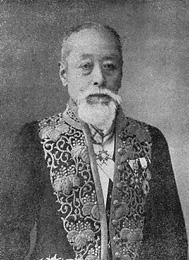Yasutsugu Shigeno (Yasutsugu Shigeno)

He was born in Sakamoto-mura Village, Kasgohima Country, Satsuma Province. In 1864, he became an instructor at hanko (a domain school) of the Satsuma Domain, Zoshikan school, and by the order of the so called ‘adored leader as father of the Satsuma Domain,’ Hisamitsu SHIMAZU, he wrote “Kochoseikan” (imperial court almanac). He also became a student of Shoheiko (a school run by Edo bakufu) and learned from Toin SHIONOYA and Sokken YASUI. Around this period, accused guilty upon his colleague’s peculation, he was exiled to a remote island, where he met Takamori SAIGO.
He took charge of the postwar process of the Anglo-Satsuma War, together with Michihira IWASHITA and others.
In 1871, he went up to Tokyo, and from 1875, he was involved the historiography project carried out by the Meiji government at Shushikan affiliated to the Bureau of Historiography, Dajokan-Seiin (the Grand Council of state).
In 1879, he became a member of the Imperial Academy
In 1881, he participated in the compilation of “Dainihon hennenshi” (Great Japanese Chronological History).
He advocated the historical science methodology, which modeled its methodology for the Qing-style study of old documents, and based on this, he denied the existence of Takanori KOJIMA (a personage appears in “Taiheiki” story) as a real figure as well as the anecdotes related to Masashige KUSUNOKI, and thus, he was dubbed ‘the doctor elimination.’
However, these arguments intensified the confrontation with the scalars of Kokugaku (the study of Japanese classical literature and culture) such as Oko KAWADA, and historians of Mitogaku (the scholarship and academic traditions that arose in the Mito Domain), and later this confrontation resulted in one of the causes of the Kume Kunitake Incident (troubles brought on by what Kunitake KUME’s has written). In 1888, he assumed the post of professor at Imperial University (later Faculty of Literature, The University of Tokyo), and the following year he became the first president of ‘Shigakukai’ (The Historical Society of Japan).
During this period, he also became a member of the Tokyo Academy as it was founded, and he insisted abolition of the Japanese reading of Chinese characters in the kanbun (Chinese classics), and improving the level of Chinese language education by exclusively using original Chinese reading. He formed a friendship with Wang Tao, a Qing’s intellectual involved in the Western Affairs Movement, who came to Japan in the same year (1879), and influenced by the association with Wang, he took part in Koakai group, the first organization of full-blown Asianism in Japan founded the following year.
He wrote “Ako-gishi Jitsuwa” (The real story of loyal retainers of Ako) from the standpoint of the modern positivist study of history in 1889. He refuted the conventional evidences used in order to support the runaway story of the Ako Roshi (lordless samurai of Ako Domain) Nobuyuki TERASAKA, and in turn, he presented some historical materials to testify Terasaka’s participation in the raid. It is said that since then, the Terasaka’s runaway story came to be less mentioned.
In 1890, he wrote “Kokushigan” (a vision on the national history), together with Hisashi HOSHINO and Kunitake KUME. In the same year, he was appointed a member of the House of Peers (Japan) by the imperial command. However, he was involved in the troubles brought on by what Kunitake KUME had written (the Kume Kunitake Incident) in 1892, and the following year he resigned his post of professor at Imperial University, and consequently the historiography project was halted.
In 1910, he died at the age of 83. His grave is located in Yanaka Cemetery in Taito Ward, Tokyo Metropolis.
His adoptive daughter Nao (尚) married into the first son of Toshimichi OKUBO, Toshikazu OKUBO.
He wrote “Seisai Bunshu” (Seisai’s writings), “Seisai Bunnishu” (Seisai’s writings II), “Seisai-sensei Ikoshu” (Professor Seisai’s literary remains), and his collection of papers, “Shigeno Hakase Shigaku Ronbunshu” (Collection of history papers of Dr. Shigeno) consisting of three volumes and an appendix was also published. His letters and other written materials were compiled by Tsukumo SAKAGUCHI as “Shigeno Seisai-ate Shoke Shojo” (Letters directed to Seisai SHIGENO from various scholars) and “Kohon: Shigeno Seisai-den” (Manuscript: biography of Seisai SHIGENO), and these are housed in the National Diet Library.
Born
- November, 24, 1827
Died
- December, 06, 1910
Cemetery
- Yanaka Cemetery
- Taito Ward, Tokyo

